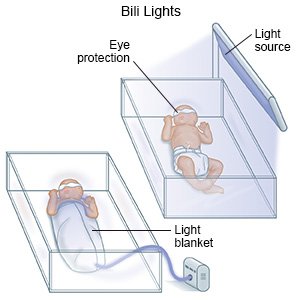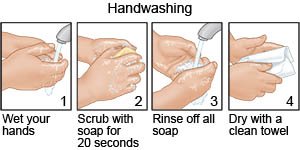Cephalohematoma
Medically reviewed by Drugs.com. Last updated on Apr 6, 2025.
What is a cephalohematoma (CH)?
A CH is a collection of blood under your baby's scalp. This condition usually happens when blood vessels rupture (burst) during vaginal birth. Blood leaks out of the blood vessels and pools in an area. A CH usually forms on 1 side of the head. Rarely, it may form on both sides.
What increases my baby's risk for a CH?
- Labor that lasts longer than is typical
- A traumatic delivery, or use of forceps or a vacuum device during delivery
- The baby's head is too large to pass through the birth canal
- Uterine contractions that are too weak to push the baby out
- Cesarean (C-section) to deliver the baby after the first stage of labor
- The baby's position in the uterus is turned, or the baby's head presses on the mother's bones
- Pregnancy with more than 1 baby
- A congenital condition such as von Willebrand disease that prevents your baby's blood from clotting
What are the signs of a CH?
- A bump or bulge on the top or back of your baby's head that may range from small to large
- A part of the scalp that moves easily over a swollen area
- An area that may feel soft at first and become hard days later
- Jaundice (yellowing of the skin or whites of the eyes) as the blood is absorbed
- Pale skin, weakness, or dark urine from anemia (low red blood cells)
How is a CH diagnosed?
Your baby's healthcare provider will examine your baby. Tell the provider if you have noticed changes to the shape or size of your baby's head. The provider may ask for details about your baby's birth. Any of the following may be used to confirm or rule out a CH:
- An x-ray, CT scan, or ultrasound may be used to check for a skull fracture or other health problem.
- A blood test may be used to test how well your baby's blood clots. Tests may find a congenital condition that causes bleeding or clotting problems.
Drugs used to treat this and similar conditions
Vitamin B6
Vitamin B6 is used for anemia, dietary supplementation, drug induced vitamin/mineral deficiency ...
Procrit
Procrit is a man-made protein used to treat anemia caused by chronic kidney disease, chemotherapy ...
Omvoh
Omvoh is used to treat moderate to severe ulcerative colitis or Crohn's disease in adults. This ...
Revlimid
Revlimid is used to treat types of multiple myeloma, mantle cell lymphoma, follicular lymphoma and ...
Lenalidomide
Lenalidomide (Revlimid) is used to treat multiple myeloma, mantle cell lymphoma, follicular ...
Cortisone
Cortisone systemic is used for adrenal insufficiency, ankylosing spondylitis, berylliosis ...
Triamcinolone
Triamcinolone is used to treat allergies, skin conditions, ulcerative colitis, and arthritis. Learn ...
Multivitamin with iron
Multivitamin with iron systemic is used for anemia, vitamin/mineral supplementation and deficiency
Reblozyl
Reblozyl is used to treat anemia in adults with beta-thalassemia or myelodysplastic syndromes ...
Luspatercept
Luspatercept (brand name Reblozyl) is used to treat anemia (low red blood cells) in certain ...
How is a CH treated?
Treatment is usually not needed. A CH often goes away on its own within 1 month. Your baby may need any of the following if the condition continues or causes health problems:
- Aspiration may be used to remove blood through a needle. This is usually only done if the area is infected.
- Phototherapy may be needed if your baby develops jaundice. One or more lights will be placed above your baby. Your baby will be placed face up to absorb the most light. Your baby may also lie on a flexible light pad or be wrapped in the pad. Eye covers may be used to protect your baby's eyes from the light.

- A blood transfusion may be needed if your baby develops anemia. Donated blood helps increase the red blood cells in your baby's body.
- Surgery may be needed if the shape of your baby's skull is affected. A CH that continues longer than 5 weeks may cause calcification (hard bone deposits) where the blood pools. Surgery is used to remove the deposits.
What can I do to manage my baby's CH?
- Prevent an infection. Wash your hands before you care for your baby's CH. Use soap and running water. Dry your hands with a clean towel. Keep the CH area clean and dry. Signs of infection include red, swollen, or warm skin, or discharge (fluid) draining from the area.

- Check the CH for any changes. Examples include an increase in the size or change in the shape or color. The CH should get smaller over a few days or weeks. The center may go away before the edges do. This causes the CH to look like a crater. This is expected.
- Tell your baby's provider about any behavior changes in your baby. Tell the provider if your baby starts to cry more, or crying sounds different than before. Changes in your baby's feeding or sleeping routines should also be reported. Check for jaundice or signs of anemia.
When should I seek immediate care?
- The skin over the CH is red, swollen, warm, or draining fluid.
- The CH is getting bigger instead of smaller.
When should I call my baby's doctor?
- Your baby is fussier than usual or cries and cannot be soothed.
- You have questions or concerns about your baby's condition or care.
Care Agreement
You have the right to help plan your baby's care. Learn about your baby's health condition and how it may be treated. Discuss treatment options with your baby's healthcare providers to decide what care you want for your baby. The above information is an educational aid only. It is not intended as medical advice for individual conditions or treatments. Talk to your doctor, nurse or pharmacist before following any medical regimen to see if it is safe and effective for you.© Copyright Merative 2025 Information is for End User's use only and may not be sold, redistributed or otherwise used for commercial purposes.
Further information
Always consult your healthcare provider to ensure the information displayed on this page applies to your personal circumstances.
